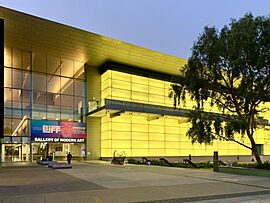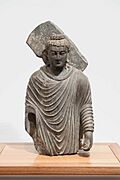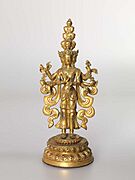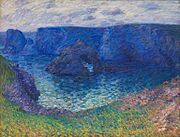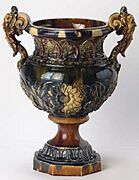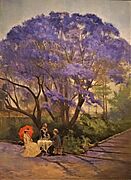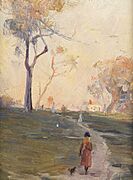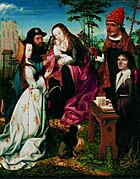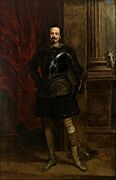QAGOMA facts for kids
|
From top: Queensland Art Gallery riverside, Gallery of Modern Art
|
|
| Established | 29 March 1895 |
|---|---|
| Location | Southbank, Brisbane, Australia |
| Type | Art museum |
| Visitors | 1,146,277 (2019/20) |
| Public transit access | Bus: Cultural Centre station Train: South Brisbane station |
The Queensland Art Gallery and Gallery of Modern Art, known as QAGOMA, is a fantastic art museum in Brisbane, Australia. It's actually made up of two main buildings. The first is the Queensland Art Gallery (QAG). The second is the Gallery of Modern Art (GOMA). These two galleries are only about 150 meters apart! You can find both of them in the Queensland Cultural Centre in South Bank. QAGOMA has a huge collection of Australian art. It is also a very important place for art from the Asia-Pacific region.
Contents
History of QAGOMA
The museum first opened its doors in 1895. Back then, it was called the Queensland National Art Gallery. For many years, it moved around to different temporary spots. In 1982, the gallery finally got a permanent home. This was the Queensland Art Gallery building. It was designed by a famous architect named Robin Gibson.
Later, in 2006, a second building was opened. This was the amazing Gallery of Modern Art, or GOMA. GOMA even won an award in 2007 for its cool design!
What You Can See at QAGOMA
QAGOMA is a popular name for the Queensland Art Gallery and the Gallery of Modern Art. The Queensland Art Gallery (QAG) is the main building. The Gallery of Modern Art (GOMA) is the second building. GOMA is also home to the Australian Cinémathèque. This is a special place for showing movies. Both buildings are in the Queensland Cultural Centre in South Bank, Brisbane. They are only about 150 meters from each other.
Many people visit QAGOMA every year. For example, in 2019–2020, over 1.1 million people came to see the art! QAGOMA is also home to the Australian Centre of Asia Pacific Art. It hosts a big art event called the Asia Pacific Triennial of Contemporary Art.
Meet the Curator
A curator helps choose and look after the artworks in a museum. Peter McKay joined the QAGOMA team in 2011. On August 8, 2018, he became the Curatorial Manager of Australian Art. This means he helps manage the collection of art from Australia.
Amazing Art Collections
QAGOMA has more than 20,000 artworks! These artworks come from Australia and all over the world. They have a very important collection of modern art from Asia and the Pacific. The museum also has large collections of Asian, Oceanian, Australian, and Indigenous Australian art.
Asian Art Collection
The gallery's older Asian art collection goes way back in time. It shows art from the Neolithic period up to the 1900s. This collection highlights how art changed with new ideas and techniques. It also shows how different cultures in Asia shared ideas. You can see paintings, prints, sculptures, and more. There are also ceramics, textiles, and furniture.
Some cool things in this collection include:
- Ancient Pottery
- Old jars from Japan (3000–2000 BCE) and China (3500–3000 BCE).
- Pottery from the Tang (618–907) and Ming (1368–1644) dynasties in China.
- Beautiful blue and white porcelain from the Qing dynasty (1644–1912).
- Special jars from Japan's Six Ancient Kilns.
- Ceramics made by Ōtagaki Rengetsu (1791–1875).
- Japanese Paintings
- Screens from the Hasegawa school (1600–1868).
- Scenes from The Tale of Genji by Tosa Mitsuatsu (1734–64).
- Birds and flowers of the four seasons by Kanō Yasunobu (1613–85).
- Japanese Prints
- Ukiyo-e prints by Hiroshige (1797–1858).
- Works by early masters like Utamaro (1753–1806).
- Prints by later artists like Toyohara Chikanobu (1838–1912).
- Art from South and Southeast Asia
- Bronze sculptures from ancient India.
- Small, detailed paintings from the Mughal and Rajput courts.
- Fancy weapons from Indonesia and Malaysia.
QAGOMA's modern Asian art collection is one of the biggest in the world. It has over a thousand artworks from the late 1960s until today. These artworks show how society and art have changed in Asia. The collection features top artists from all over Asia. It also includes artists of Asian heritage living in other countries. You can see works by famous artists like Xu Bing, Yayoi Kusama, and Ai Weiwei.
- Asian Art collection
-
Buddha, 2nd-3rd century CE - Unknown
Australian Art Collection
The gallery's Australian art collection starts from the time when Europeans first arrived. It shows important moments in Australia's history. These include first contact, settlement, and immigration. Early artworks show the influence of European art styles. Later, a unique Australian style began to appear. This was seen with the Heidelberg School movement in the late 1800s.
Many famous Australian artists are in this collection. Some names you might know are Sidney Nolan, Margaret Preston, and Arthur Streeton.
Some special paintings in this collection include:
- Australian Paintings
- Still glides the stream and shall forever glide by Arthur Streeton (1895).
- Under the Jacaranda by Richard Godfrey Rivers (1903).
- Bathers by Rupert Bunny (1906).
- Monday morning by Vida Lahey (1912).
- The Cypriot by William Dobell (1940).
- Man feeding his dogs by Russell Drysdale (1941).
QAGOMA's modern Australian collection shows how diverse people are in Australia. It includes art from the late 1960s until today. This art uses many different materials. You can see paintings, sculptures, and drawings. There are also photographs, digital art, and films. Leading artists like Patricia Piccinini and Tracey Moffatt are featured.
- Australian Art collection
-
Under the Jacaranda 1903 - Richard Godfrey Rivers
European and North American Art Collection
The gallery also has a collection of historical international art. This part focuses on art from Western Europe and North America. It covers art from the early Renaissance period up to the mid-1900s. The collection is strong in art from the Northern Renaissance. It also has many British artworks from the late 1700s to the late 1800s. This includes Victorian and Edwardian paintings.
You can also find modern European and American art. This includes paintings, sculptures, and photographs. Most of the more than 2000 artworks in this area are from Western Europe.
Some important artworks in this collection include:
- Old Master Paintings
- Virgin and Child with Saint James the Pilgrim, Saint Catherine and the Donor with Saint Peter (around 1496) by Master of Frankfurt.
- Cristo risorgente (The risen Christ) (around 1555) by Tintoretto.
- Young woman in a fur wrap (around 1629–30) by Peter Paul Rubens.
- Portrait of Marchese Filippo Spinola (around 1622–27) by Anthony van Dyck.
- Historical International collection
-
Peter-Paul-Rubens-Young-woman-in-fur-wrap-1629-30.jpg
Young woman in a fur wrap (after Titian) c.1629-30 - Peter Paul Rubens
-
Le salon des Hessel c.1905 - Édouard Vuillard
-
Giacomo Ginotti ‘Lucretia’, Queensland Art Gallery, Brisbane 02.jpg
Lucretia 19th century - Giacomo Ginotti
-
Portrait of Marchese Filippo Spinola c.1622-27 - Anthony van Dyck



